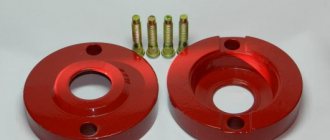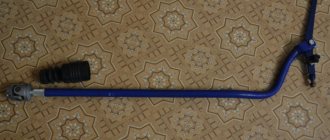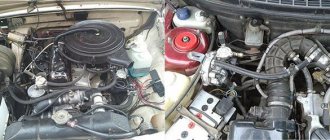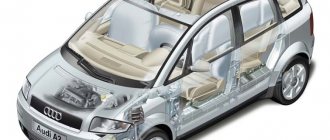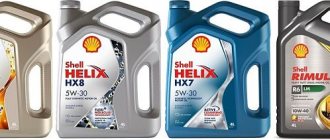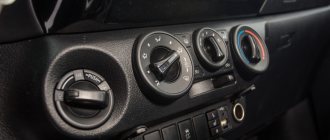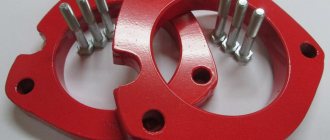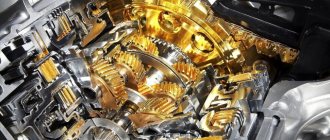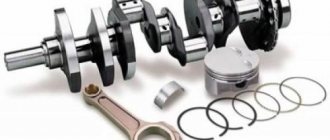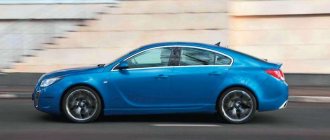Hello, dear friends! Are you bored? Me too. Today we are considering a rather interesting issue - spacers to increase ground clearance.
I know that car owners often try, on the contrary, to lower the car, to make it as low as possible. But you yourself understand who is doing this. Especially when it comes to cars such as VAZ 2109, 2110, etc.
Take any car, Peugeot, Honda, Opel, Mazda, Nissan, Toyota, Audi. Only a few of them have really high ground clearance, that is, ground clearance. And then, this mainly applies to crossovers. I agree that cars like Renault Logan and Skoda Octavia Tour are high. But the Chevrolet Lacetti, Ford Focus, Kia Sid or Rio, Mazda 3, Hyundai Accent, Volkswagen Passat sometimes clearly do not reach the height that is needed for our roads.
It is the poor quality of roads that forces car owners to change their clearance sizes. One method is spacers. They are installed in the rear and front wheels. Moreover, many do it with their own hands. A bunch of relevant training videos to help you.
Buying yourself a set of spacers is not as expensive as completely changing the springs or replacing a set of wheels with a larger diameter. Although spacers have their drawbacks.
What are they needed for
I won’t be unfounded, but I’ll just give simple examples from life. I think they will allow you to understand why it is worth considering the issue of installing spacers to increase ground clearance.
- The car is initially quite low. This applies to imported cars, since our automakers understand that fighting the roads is pointless, as is waiting for their quality to improve. Therefore, they try to adapt to current conditions, offering high ground clearance. But even that is not enough. As a result, driving through the next section, you again and again cling to the bottom, crankcase protection, cannot pass the curb, brake before each hole so as not to get hit. All this interferes with normal movement and driving turns into a test.
- You often have to load the machine. A cabin full of people or a huge amount of luggage noticeably sits down the car, which begins to scrape along the asphalt and rub its wheels against the fender liners. Agree, this is not very pleasant.
Installing spacers is the most optimal solution to the problem, if you look at it from a price-quality perspective. They increase rigidity and increase the distance from the bottom to the ground. Fortunately, my car is quite high, but this problem is very close to me, since my friends do not have such ground clearance. Actually, I would like to install inserts for them too, since I have to constantly take my car if we go somewhere in nature or outside the city. But let's not talk about sad things.
I think it’s very clear to you why these spacers are needed and what function they perform. But before you install and even purchase these elements, which are sold not only in Volgograd, but also in any cities such as Moscow, St. Petersburg, Novosibirsk, Yekaterinburg, Krasnoyarsk, etc., I suggest you find out what these spacers are.
Nuances of self-installation
Before installation, it is necessary to calculate the optimal clearance value. This parameter is different for different types of cars. For example, for passenger cars the clearance should be from 140 to 200 mm, for SUVs - from 180 to 250 mm, and for SUVs - from 200 mm to 350 mm.
If the car is under warranty, then in the event of a breakdown, the parts that were manipulated will not be covered by the warranty. Therefore, in this case, it is better to contact the official service center where you are undergoing service. This will be more expensive, but more reliable.
So, installing spacers to increase ground clearance is a fairly relevant modification for off-road driving. It doesn’t matter what material they are made of, aluminum, polyurethane or rubber: each option will give you new emotions from driving off-road and on bad roads. And in general, there is a special charm in the feeling of being elevated above other participants in the movement. But you need to remember that you cannot increase the ground clearance too much, as this may affect the stability of the car and the durability of the suspension. You can view the range of spacers here.
Varieties
There are three main types of these elements used to increase ground clearance and increase the rigidity of a car's suspension.
- Interturn. Mounted in springs. They are considered the simplest and most accessible. Strengths include ease of installation and versatility. They are mounted in the rear and front springs. However, you should not count on an increase in ground clearance. They are designed to increase rigidity. Having installed them, you can easily load the car, place bags in it and not worry that the bottom of the car will start to rub against the asphalt. Installation is generally elementary. You need to jack up the car, hang the desired wheel and stretch the spring. Then a spacer is inserted there. Advice from me personally. Before inserting the element, wet it with soapy water. This way he will easily fit into his place.
- Under the springs. The problem of insufficient ground clearance is already being solved here. The element is mounted between the spring itself and the body of your car. Please note that the ground clearance rises exactly as much as the thickness of the spacer. Remember, if you install a spacer on a body with traces of corrosion and a faulty spring, the consequences can be dire. Also, if the spring sag, spacers for the spring will be ineffective. At this point, immediately replace them with new ones.
- Spring adjustable. They perform a function similar to the previous version, but can be adjusted. Well, yes, you already understood it from the title. A good option, since you will be able to quickly change the clearance height, if necessary, depending on the load of the machine. Yes, their price is higher, but it is completely justified if you want to do everything really efficiently and usefully.
Spacers for springs
The vast majority of European passenger cars have a ground clearance of 130-150 mm. It is measured from the surface of the asphalt to the protruding parts under the bottom. Typically, manufacturers in the passport data indicate the ground clearance value without full load on straightened springs and shock absorbers, which means that with the maximum permissible weight of the vehicle, the ground clearance will drop another couple of centimeters and amount to 110-130 mm. This value is already critical for passenger vehicles if they leave smooth roads onto off-roads. It is believed that 180 mm under the bottom is required for good travel over bumps. Some SUVs have ground clearance in the range of 180-250 mm. Some owners try to bring their cars to this level of ground clearance.
Drivers previously used two methods to increase ground clearance. Most often this is done using a spacer package or using longer springs and shock absorbers.
Rubber-metal spacers can be purchased at auto tuning stores, and they are applied to standard suspension parts. They act as a “gasket” between the springs and the body. The car rises and stops scratching the bottom and sills on the protruding bumps. However, this method has disadvantages. Spacers increase the leverage on the strut, which the body leans on when cornering. The forces change, and the loads in a standard MacPherson strut break parts. Even an upward displacement of the center of mass by 15-20 mm is dangerous from the point of view of reducing the life of the constant velocity joint (CV joint).
Article on the topic
From the garage to the intensive care unit. Why is it dangerous to repair a car yourself? Its shaft rises and forces the technical unit to work under tension. In addition, the drive shaft can approach the subframe on bumps and even touch it during suspension operation.
Therefore, most often only the rear axle is lifted up. In this case, the car “lifts up” the rear, the appearance deteriorates, and there is no effect on off-road conditions.
Materials used
Reviews from friends, online users and personal observations made it clear that it is extremely important what spacers you buy. When we install the first elements we come across, bought for pennies, we greatly risk our own health and the health of our car.
Go shopping, go to the same Aliexpress, look carefully at the drawing of the proposed spacers. But the most important thing is the material they are made from.
Today spacers are produced on the basis of three different materials.
- Aluminum. Aluminum spacers are quite reliable. By installing them, you will eliminate the process of deformation of the bushings, and also provide a fairly high level of comfort. Many spacers have a negative impact on the ride comfort and performance of the car. Aluminum, as a rule, affects these characteristics less than others.
- Polyurethane. Polyurethane analogues are deformed due to the impact of springs on them when you often drive on uneven roads. Therefore, over time, the risk of damage to the body by its own bushings increases.
- Polymer or plastic. Plastic products are the most reliable and high quality. But only on condition that you buy spacers from truly proven and well-established manufacturers.
Types of spacers to increase ground clearance
The choice of modification depends on the make of the car. Aluminum and steel options are used for the front shock absorbers. They are a box with holes for fastening.
Spacers for the rear spring are made of high-density rubber, polyurethane or plastic. They are shaped like rings with three eyes.
There are also spacers to increase ground clearance, the core of which is made of steel and the body is made of polyurethane. They have a serious drawback - the body wears out faster than the inside, so there is a risk of damage to the car body.
Aluminum spacers are more reliable, but this metal is susceptible to corrosion. Ultimately, plastic proves to be the most reliable, which is why car owners prefer such modifications.
Is it necessary to register a passenger trailer with the traffic police?
The reason to refuse spacers may be the fact that after their installation the levers are lowered and are constantly in this state. As a result, the geometry is disrupted, the suspension system works differently, and changes for the worse, the previous sensitivity of the steering is lost, and the car can skid at high speeds.
Spacers also increase the load on the suspension itself; silent blocks, shock absorbers, and steering rods wear out.
It's up to you to decide. Think about where to buy spacers and whether it is worth buying them specifically in your case. It may be easier to change the wheels or the springs themselves. It's more expensive, but safer.
Share your impressions if you have used spacers. Don't forget to leave comments, invite your friends and tell everyone you know about us. This is not difficult for you, but we are incredibly pleased!
Impact on vehicle behavior
Engineers who develop the car design calculate all the parameters in such a way as to ensure the desired characteristics. Therefore, sports cars and similar types of cars are “pressed” to the road surface as much as possible, which is necessary for stability and controllability at high speed. SUVs, not designed for driving too fast, are raised above the road surface, since their main task is to successfully overcome obstacles in conditions of bad roads or their complete absence.
The high ground clearance of SUVs allows them to overcome serious obstacles
It's all about the car's center of gravity, which rises along with the body as the ground clearance increases, which leads to the following consequences:
- Vehicle controllability decreases as speed increases.
- The car rolls more when cornering, and the braking distance increases.
- Fuel consumption increases.
- While driving, the air flow in the space under the car increases. The higher the speed, the worse the grip of the wheels on the asphalt becomes.
You can't lift a car body that much
Advice. Deterioration in driving performance will remain almost unnoticeable if you correctly carry out the work to increase the ground clearance. An ordinary passenger car cannot be lifted higher than 5 cm without consequences.

